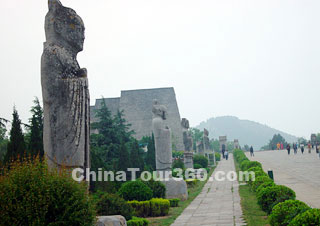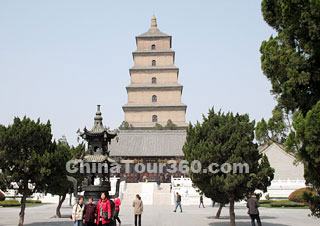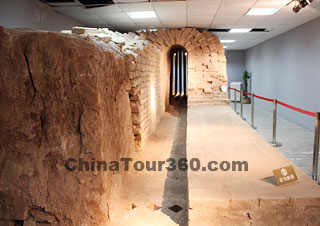Liyuan, an aristocrat stationed in present-day Shanxi Province during the last part of the Sui Dynasty (581 - 618), took advantage of the political chaos to seize Chang'an City as his capital in the year 618, beginning another new and prosperous dynasty in Chinese history, the Tang Dynasty (618 - 907). It is regarded as one of the most prosperous dynasties in Chinese history. Many historians often compare it with the Han Dynasty (206BC - 220AD) which was another golden time in Chinese civilization. The Tang's national territory was larger than that of the Han Dynasty. Compared to the far-reaching influence of Han culture, Tang culture has had greater influence on both the Chinese and people abroad.
 |
| Qianling Mausoleum in Xianyang, Shaanxi |
Two pinnacles, almost in succession, appeared thanks to the Tang emperors' enlightened rule, during this unprecedented era in Chinese history. They were the 'Prosperity of Zhenguan' during the reign of Liyuan's son, Emperor Li Shimin (627 - 649) (a.k.a., Tang Taizong) and the 'Heyday of Kaiyuan' during the reign of Emperor Li Longji (712 - 756) (a.k.a., Tang Xuanzong). Between these two periods China's only female emperor, Wu Zetian, appeared and established her regime-Zhou (690 - 705). All these made China the largest and richest country in the world at that time.
After the outbreak of the Anshi Turmoil, during which Emperor Li Longji neglected state affairs and fell in love with his concubine, Yang Kwei Fei, the Tang Dynasty's power ebbed. Finally, because of domestic economic instability and regional separatism, the dynasty came to an end. In 907, the leader of a peasant uprising, Zhu Wen, established a new regime-Later Liang, and China began a half-century of political fragmentation, known as the Five Dynasties and Ten States.
![]() Economy
Economy
Economic development recorded in the Tang Dynasty was unprecedented. Several conditions brought this about: transportation either by road or by sea was convenient due to the unhindered Silk Road; the early emperors' wise policies such as alleviating forced labor and some taxes made people work more enthusiastically; the government paid greater attention to foreign relations, which promoted frequent transactions between China and nations abroad. In agriculture: South China became an important base for food supplies; cropland irrigation and tools for agriculture were further developed, including the invention of the Quyuan Plough and the Tong Irrigator; tea became a daily necessity and farm produce in general was more commercialized.
In handicrafts: Areas for producing silk products, flax products and porcelain were distributed all over the country; large-scale production of ocean-going boats made China their base during the Tang Dynasty; product categories increased, as in the case of damask silk, which had more than twenty categories and the famous Tang tricolor porcelain appeared during this period. Engraved block printing appeared at the beginning of the dynasty and explosive powder had been put into military use since the middle of the Tang Dynasty.
In commerce: Due to practical transportation on canals and the Yangtze River, the merchant fleet shuttled in an endless stream. The Kaiyuan Tongbao, a Tang-dynasty gold-plated coin, became the standard currency; Gui Fang (a shop for money exchange) appeared and became a rudimentary bank, some six or seven hundred years earlier than what appeared in the Mediterranean area. Near the end of the dynasty, the night market appeared in some flourishing cities such as Chang'an (present-day Xian) and Luoyang near the Yellow River, as well as in Yangzhou and Chengdu along the Yangtze River.
![]() Foreign Relations
Foreign Relations
Admired by people abroad, Tang culture spread to Asia, Europe and Africa. Neighboring countries sought and established relations with the government and the capital, Chang'an, became the center of cultural exchanges between the East and the West. These countries included Xinluo (the countries in the Korean Peninsula), Japan, Tianzhu (present-day India), Bosi (present-day Iran), etc. The ambassadors of the Tang Dynasty and the above countries visited each other which promoted cultural exchanges. They sent each other special local products and books on various subjects.
|
|
![]() Religion
Religion
Originating in ancient India around the time of Confucius, Buddhism flourished during the Tang Dynasty. Since then it has thoroughly became a part of China's traditional culture. A monk, Xuanzang, and his party went to Tianzhu (present-day India) in order to obtain the Buddhist sutra. Journey to the West, one of the four great classics of ancient China, recorded this historical event in a mythological form.
![]() Science
Science
An excellent Tang astronomer, Yixing, created the Dayan Calendar, which described the sun's orbit and showed the maturity of the ancient Chinese calendar. Yixing was also the first to measure the length of the earth's meridian in a practical, scientific way.
![]() Medicine
Medicine
One famous expert in traditional Chinese medicine, Sun Si-Miao, wrote Priceless Prescription (Qian Jin Fang) a book which comprehensively included the medicinal achievements of the time. Revised by Tang Gaozong, Tang Ben Cao (Materia Medica of the Tang Dynasty) has been regarded as the first pharmacopoeia issued by the state.
![]() Literature
Literature
In terms of literature, it was the poetry of the time that placed the Tang Dynasty above all others. There were many great poets who lived in this dynasty: Li Bai, Du Fu, Bai Juyi, etc. They created many famous poems which have been recited by Chinese people from generation to generation. A prime example is Thoughts in a Tranquil Night, created by Li Bai. These poems form a significant part of Chinese cultural heritage and attest to the intelligence and creativity of the ancient Chinese people.
![]() Go to the Five Dynasties and Ten States
Go to the Five Dynasties and Ten States









